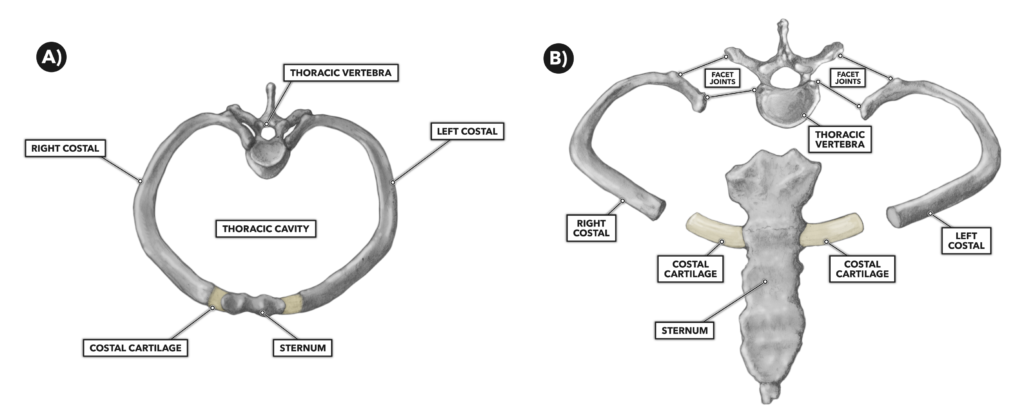The thoracic vertebrae each articulate with two costal bones, otherwise known as ribs, to form the major structural elements of the thoracic cavity—also known as the thorax or simply the chest. There are four bones that establish the anatomical boundaries of the thoracic cavity (Figure 1), which houses the heart, lungs, and much more:
- A thoracic vertebra (T1 through T12)
- Two costals (rib bones)
- The sternum
The first seven thoracic vertebrae articulate with the costals to the posterior (as in Figure 1a). Each costal or rib articulates with the vertebra above it, the vertebra below it, and the transverse process posterior to it. Each rib also articulates with the sternum to the anterior (as in Figure 1b).
The eighth, ninth, and 10th pairs of ribs vary slightly from this pattern. Like the first seven pairs, they articulate with the corresponding vertebrae to the posterior. However, they share a single articulation with the sternum to the anterior via a merger of their costal cartilages.
A major deviation from this structural template can be seen in the final two pairs of ribs, which articulate with T11 and T12. These costals are small and not long enough to articulate with the sternum.
When we consider the individual pairs of costals (right and left), we see changes in shape and size as we go down the vertebral column from T1 to T12, just as we do with the thoracic vertebrae themselves (Figure 2).

Figure 2: Changing shapes and sizes of the costals as we go down the vertebral column
The sternum is an important anterior skeletal structure that serves as an articulation point for the ribs and a point of attachment for the musculature. The bone is divided into three segments: the manubrium, body, and xiphoid process (Figure 3).

Figure 3: Segments of the sternum
The function of the thoracic bones is primarily to support and protect all the organs and tissues within the chest cavity, and to a lesser degree, the abdominal cavity inferior to it. The rib cage is robust and impact resistant as well as mobile. The mobility of the cartilaginous joints to the anterior (attaching to the sternum) is helpful in external respiration (breathing) and adds to the protective and shock-absorptive nature of the ribs.
